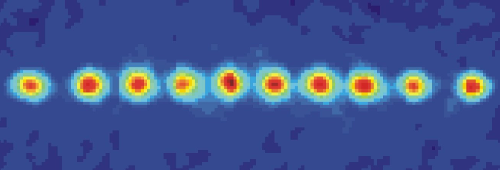Noise Improves Flow of Energy
When electrons move in a conducting material or when energy absorbed from sunlight is shifted between molecules during photosynthesis, the process can be described using the wave equations of quantum mechanics. Wave interference can lead to a suppression of the transport of charge or energy, but, counterintuitively, random fluctuations such as thermal noise can actually improve this transport. Researchers have now demonstrated both of these effects for energy transport in a chain of ten atoms, where the degree of disorder and noise in the system can be carefully controlled. Studying such effects in a clean, well-controlled experiment could lead to a better understanding of how they operate in larger, more complex situations such as in electronic and optical devices.
An electric current can be described as a wave, but so can other kinds of energy transport. For example, energy can be transferred between atoms or molecules as a series of absorption and emission events of photons, which can be represented as a wave of energy moving from one component to the next. If the waves remain in step, they are said to be coherent, in which case constructive interference (alignment of peaks and troughs) can amplify the flow of charge or energy. But disorder, such as impurities or defects in the lattice of atoms, may cause coherent destructive interference (peaks canceling out troughs) that averages out to suppress the flow entirely. This suppression, which can trap charge or halt the flow of energy in a specific region, is called Anderson localization.
Theoretical studies have predicted that noise in these quantum waves, such as that from thermal fluctuations, may have the surprising effect of breaking down Anderson localization and boosting transport. This boost occurs because noise destroys the coherence of the waves and so removes the possibility of coherent destructive interference. The effect is known as environment-assisted quantum transport (ENAQT), and it has been reported previously in systems ranging from optical fibers [1] to superconducting circuits [2]. It has also been suggested that ENAQT might operate in photosynthetic energy transfer [3], although this hypothesis remains unproven.
Most of the previous studies of ENAQT used just a few macroscopic and therefore hard-to-control components, or they contained too few components to be relevant for real materials [4]. To investigate the effect in a clean, well-defined, many-particle system, Christian Roos of the Institute for Quantum Optics and Quantum Information in Innsbruck, Austria, and coworkers reproduced it in ten calcium ions suspended in a row in free space by electric fields.
The trapped-ion array was essentially a one-dimensional crystal. The researchers could switch the ions between two electronic states, and, when injecting energy into the array using a laser pulse, they could monitor the wavelike passage of the energy along the array from ion to ion. To make the system somewhat disordered and induce Anderson localization, they could vary the transition energies of the ions along the chain by exciting each one with a beam of a different intensity. With ten separate beams, “we can create disorder in a very controlled way that can be switched on and off on short time scales,” says Roos.
In the team’s experiments, when the degree of disorder was high, they found that energy transport along the chain was lowered by Anderson localization, as expected. But when Roos and colleagues introduced noise into their array by rapidly changing the beam intensity exciting each ion, so that the transition frequencies “wobbled,” things changed. The transport efficiency increased with increasing noise level, consistent with ENAQT predictions.
However, if the noise was too great, the energy transport declined again, thanks to the so-called quantum Zeno effect: In the ion-array experiments, a high level of noise mimics the effect of repeated observation, which, according to quantum mechanics, can freeze a system and suppress any change of state.
Roos says that his team’s setup allows such quantum effects to be studied “in artificially engineered quantum systems where we have excellent control over the network connectivity, coupling strengths between sites, [and] local disorder.” ENAQT, or more generally, transport processes influenced by their environment, may occur in a wide range of systems and so are important to investigate, says Clemens Gneiting, a quantum physicist at RIKEN, near Tokyo. “That they can investigate it here with high precision and clean control of the system on the quantum level allows for clear comparison with theory.”
This research is published in Physical Review Letters.
–Philip Ball
Philip Ball is a freelance science writer in London. His latest book is How Life Works (Picador, 2024).
References
- S. Viciani, M. Lima, M. Bellini, and F. Caruso, “Observation of noise-assisted transport in an all-optical cavity-based network,” Phys. Rev. Lett. 115, 083601 (2015).
- A. Potočnik et al., “Studying light-harvesting models with superconducting circuits,” Nature Commun. 9, 904 (2018).
- S.F. Huelga and M.B. Plenio, “Vibrations, quanta and biology,” Contemp. Phys. 54, 181 (2013).
- D. J Gorman, B. Hemmerling, E. Megidish, S. A. Moeller, P. Schindler, M. Sarovar, and H. Haeffner, “Engineering vibrationally assisted energy transfer in a trapped-ion quantum simulator,” Phys. Rev. X 8, 011038 (2018).





